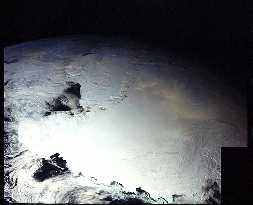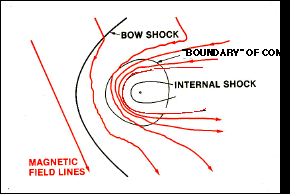This is an image of Pluto with its moon Charon.
Click on image for full size
NASA
Discover Pluto
After the discovery of Neptune in 1846, mathematical theory suggested that there still might be a ninth planet. Scientists set out to discover it, and it was finally identified in 1930 by Clyde Tombaugh after a careful search of the sky.
Finding Pluto was difficult. It had to be done by noticing its motion against the background of stars. Because Pluto is so small, it is also very dim in the sky. At 39 Astronomical Units from the sun, and with 248 years to complete its orbit around the sun, Pluto also moves very slowly. So it was many years before the 9th planet could be identified by its motion.
Pluto is named after the Roman god of the underworld. It has one moon named Charon. The two objects act more like a double planetary system. They orbit each other, as if they were in a standoff, waiting for the other to turn their back. Some people say that Pluto isn't a planet at all, but rather a satellite that escaped Neptune's gravitational pull.
You might also be interested in:

Pluto has // Call the moon count function defined in the document head print_moon_count('pluto'); known moons. Charon, the largest by far, was discovered in 1978 by the American astronomer James Christy.
...more
Of all the planets and moons in the solar system, Pluto and Charon are the two which resemble each other the most closely. They are almost the same size, and they are very close together. They are so
...more
It may seem hard to believe that Pluto could have an atmosphere because it is so cold at 39 AU, where Pluto resides, but it does. Because there are times when Pluto is closer to the sun than is Neptune
...more
Pluto is a frigid ball of ice and rock that orbits far from the Sun on the frozen fringes of our Solar System. Considered a planet, though a rather odd one, from its discovery in 1930 until 2006, it was
...more
Pluto is so far away, and has never been explored. Questions to answer about Pluto include the following: What are the geologic features of the surface. (pictures of the surface) If there are bare spots,
...more
No one knows whether or not Pluto has a magnetosphere. Scientists were very surprised to find that Jupiter's icy moon Ganymede had a magnetosphere because it is hard to explain how an icy body can develop
...more
The diagram to the left shows a cutaway of the possible interior structure of Pluto. The composition of Pluto is mostly ice, therefore there is probably a small core of some rocky material buried inside,
...more














